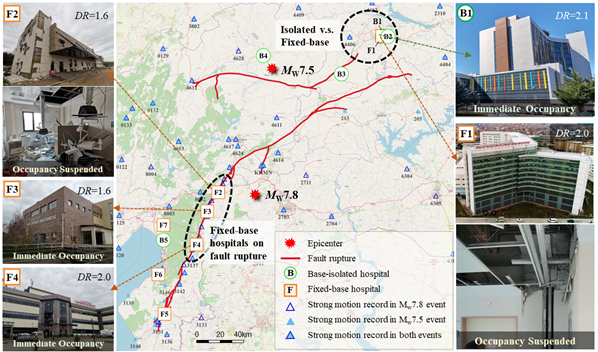How Earthquakes Impact Hospitals: Insights from the 2023 Turkey Earthquake Sequences
Published 30 June, 2023

On the early morning of February 6, 2023, a very strong earthquake with a magnitude of 7.8 hit an area in southcentral Turkey and northwestern Syria. About 9 hours later, another powerful earthquake measuring 7.5 struck a nearby region called Kahramanmaraş Province. Both events led to the severe destruction of properties and lives.
The ability of medical systems to withstand earthquakes is extremely important for the overall resilience of communities in seismic events. To that end, a team of experts in structural and earthquake engineering from the China Earthquake Administration worked on-site to assess the extent of damage to buildings and infrastructure in seven highly impacted provinces in southcentral Turkey, namely Adana, Adıyaman, Gaziantep, Hatay, Kahramanmaraş, Malatya, and Osmeniye.
“Our study specifically examined the response of two types of hospital buildings: five with base-isolated structures and seven with fixed-base structures,” shared Zhe Qu, lead author of the study. “Through an extensive field survey of 12 hospitals impacted in those provinces, we gained valuable insights into the seismic performance of these critical healthcare facilities.”
In particular, the team defined a demand ratio to estimate the actual seismic demand experienced by the building. This ratio is calculated by comparing the recorded spectral acceleration from a representative nearby strong motion record to the spectral acceleration of the 10%-in-50-years design spectrum outlined in the 2018 Turkish code for the seismic design of buildings.
“The demand ratio indicates that the majority of the buildings examined faced seismic actions that exceeded their intended design levels,” said Qu.
Other key findings from the report include:
The superior performance of base-isolated hospital buildings: Hospital buildings equipped with friction pendulum bearings, employing base isolation systems, generally exhibited superior performance in achieving the goal of immediate occupancy and providing better protection for nonstructural elements.
Collapse prevention of fixed-base hospital buildings: Despite being subjected to seismic demands that surpassed their design limits, fixed-base hospital buildings constructed with reinforced concrete structures after 2001 effectively prevented collapse and many of them remained operational during the earthquakes.
The report, published in the KeAi journal Earthquake Research Advances, serves as a vital resource for policymakers, engineers, and emergency management agencies. It provides valuable insights and guidance for enhancing the seismic resilience of hospital facilities and refining disaster response strategies.
“Gaining insights into the performance of fixed-base hospitals that can be occupied immediately, as well as seemingly unscathed base-isolated hospitals, during high-demand seismic events, will play a crucial role in strengthening community resilience against future earthquakes,” concluded Qu.
For more information or to request an interview with the researchers, please contact:
Contact author details:
Zhe Qu, Key Laboratory of Earthquake Engineering and Engineering Vibration, Institute of Engineering Mechanics, China Earthquake Administration, quz@iem.ac.cn
Qu, Z., Wang, F., Chen, X., Wang, X., Zhou, Z., Rapid report of seismic damage to hospitals in the 2023 Turkey earthquake sequences, Earthquake Research Advances (2023), doi: https://doi.org/10.1016/j.eqrea.2023.100234

